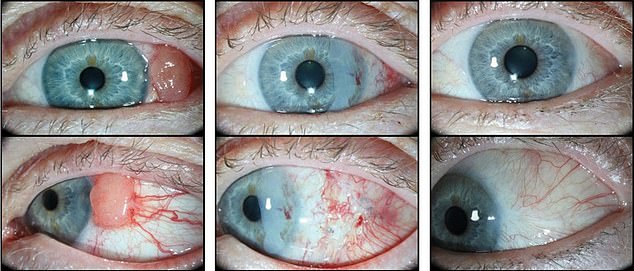Woman thought she had ‘dirt in her eye’ – in reality it was a deadly, rare form of skin cancer that forced doctors to remove her eyeball
A Swedish woman had to have her entire eye removed after complaining of a foreign body in her left eye, which turned out to be a rare form of skin cancer.
Photos show an ugly bump on her eyelid, which turned out to be indicative of the disease.
The 81-year-old woman had a rare form of melanoma, a type of skin cancer that can rarely develop in the eye.
Skin cancer in the eye is very rare. Only one in two million people suffer from it each year.
But the elderly Swede was even more unlucky: her skin cancer was particularly difficult to detect due to the lack of pigmentation.
Medically, these cancers are called amelanotic and they occur in only one in ten cases of melanoma.
Swedish doctors have also described another horrifying case of the disease, this time in a 50-year-old woman. These images show the dramatic growth of the lesion that turned out to be cancer
It is usually only discovered at a later, more serious stage.
The unnamed elderly Swedish woman was treated by eye specialists at Skaraborg Hospital for swelling of her eyelids and the feeling that something foreign, such as dirt, was in her eye.
Despite being prescribed medications to reduce the swelling, she was still experiencing problems a few weeks later.
This prompted a closer examination of her eye, which revealed a tumor-like growth on the inside of her eyelid.
Biopsies were taken which showed it to be an amelanotic melanoma in the eye.
Doctors who described the case in detail, Journal of Medical Case ReportsDetailed scans were then taken of the patient’s eyes, neck and head to check whether the cancer had spread further to nearby tissues.
Unfortunately, the images showed that a tumor may be growing in the eye itself, specifically in the muscles that help the organ move sideways.
Doctors recommended removing the patient’s eye because there was no way to remove the tumors and keep the eye intact.
They reported that the surgery was successful. The primary tumor on the inside of her eyelid was 13 mm wide and 7 mm deep.

Unlike the 81-year-old woman, her entire eye did not need to be removed, as laboratory tests revealed the growth was in fact cancerous. These images show the difference before surgery (left), after surgery (center), and six months later (right).
Doctors said the patient was doing well nine months after surgery, with no further signs of cancer and wearing a prosthesis.
Swedish doctors also described another alarming case of the disease, this time in a 50-year-old woman in 2022.
The woman had been suffering from a defect in her left eye for a few months, which was causing her health problems. She then sought help from her family doctor.
Her GP referred her to an eye specialist, who diagnosed a deviation of 2 mm by 4.8 mm and scheduled an appointment for more extensive testing.
Doctors did not say how long the woman had to wait for these tests, but they did say that when she returned, the lesion had grown dramatically to 4 by 5 mm.
She was scheduled to undergo surgery to remove what doctors now suspected was amelanotic skin cancer in her eye. The surgery was successful.
Unlike the 81-year-old woman, she did not need her entire eye removed, but laboratory tests revealed it was a malignant tumor.
She underwent preventive radiation therapy to remove any remaining traces of the cancer.

Eye cancers of any kind are rare, with only around 900 cases diagnosed in the UK each year.
Fortunately, subsequent scans found no traces of the disease, but the woman will need annual cancer checks for the rest of her life.
The experts concluded their report by stating that the rarity of this type of tumor makes research into treatment and prevention difficult.
They added that this rarity means that patients and doctors may mistake the condition for a benign one, which can delay diagnosis.
The British charity Cancer Research UK describes melanoma of the eye as ‘extremely rare’ and treatment mainly consists of a combination of surgery and radiotherapy, which uses radiation to kill cancer cells or potential cancer cells.
Eye cancer, in any form, is rare, with only around 900 cases diagnosed each year in the UK.
About two in five patients die within ten years of diagnosis, with approximately 130 deaths per year.
